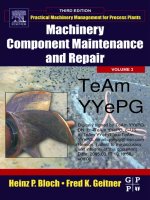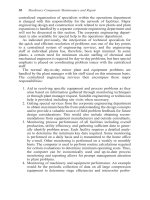Starting System Testing and Repair
Bạn đang xem bản rút gọn của tài liệu. Xem và tải ngay bản đầy đủ của tài liệu tại đây (3.85 MB, 61 trang )
by
Russell Krick
Publisher
The Goodheart-Willcox Co., Inc.
Tinley Park, Illinois
© Goodheart-Willcox Co., Inc.
Permission granted to reproduce for educational use only
© Goodheart-Willcox Co., Inc.
Permission granted to reproduce for educational use only
Starting system diagnosis
Battery cable service
Starter solenoid service
Ignition switch service
Starter relay service
Neutral safety switch service
Starter service
© Goodheart-Willcox Co., Inc.
Permission granted to reproduce for educational use only
© Goodheart-Willcox Co., Inc.
Permission granted to reproduce for educational use only
Common Problems
No-crank problem
crankshaft does not rotate
Slow-cranking condition
crankshaft rotates slower than normal
Solenoid clicking
caused by low battery or poor
connections
Noises
caused by overrunning clutch or flywheel
tooth wear
© Goodheart-Willcox Co., Inc.
Permission granted to reproduce for educational use only
Common Problems
Check for these kinds of problems
© Goodheart-Willcox Co., Inc.
Permission granted to reproduce for educational use only
Starting Headlight Test
Turn on headlights; try to start engine
No cranking with no headlights
dead battery
open in the electrical system
Headlights go out when cranking
heavy current draw (starter), low battery,
or engine too hard to crank
Headlights stay bright, no cranking
high resistance or open in starting circuit
© Goodheart-Willcox Co., Inc.
Permission granted to reproduce for educational use only
Fusible Link
If major components are dead,
check fusible links
© Goodheart-Willcox Co., Inc.
Permission granted to reproduce for educational use only
Checking the Battery
Verify battery condition
Load test if necessary
Starter current flow may exceed 200
amperes, requiring high battery output
© Goodheart-Willcox Co., Inc.
Permission granted to reproduce for educational use only
Starter Current
Draw Test
Measures the current used by the
starting system
Connect a voltmeter and ammeter
Disable the engine
disconnect the coil primary supply
ground the coil wire
disable the electric fuel pump
Crank the engine for 15 seconds while
noting voltage and current readings
Compare the readings to specifications
© Goodheart-Willcox Co., Inc.
Permission granted to reproduce for educational use only
Equipment Connection
A voltmeter is
needed to verify
battery condition
© Goodheart-Willcox Co., Inc.
Permission granted to reproduce for educational use only
Starter Current Draw
Test—Load Tester
Crank the engine, noting the voltage
Load the battery to the same voltage
The amperage will equal starter current draw
© Goodheart-Willcox Co., Inc.
Permission granted to reproduce for educational use only
Load Tester
Connection
© Goodheart-Willcox Co., Inc.
Permission granted to reproduce for educational use only
Disabling the Ignition
On a distributor ignition system,
ground the coil wire
© Goodheart-Willcox Co., Inc.
Permission granted to reproduce for educational use only
Disabling the Ignition
With a coil pack, disconnect the
primary wires
© Goodheart-Willcox Co., Inc.
Permission granted to reproduce for educational use only
Starter Current Draw
Test Values
© Goodheart-Willcox Co., Inc.
Permission granted to reproduce for educational use only
Voltage Drop Tests
Locates higher-than-normal resistance
Whenever current flows through a
circuit, electrical resistance causes a
voltage drop
© Goodheart-Willcox Co., Inc.
Permission granted to reproduce for educational use only
Insulated Circuit
Resistance Test
Connect the voltmeter between the battery
positive and the starting motor terminal
Crank the engine, noting voltage
Maximum should be 0.5 volts
Excessive voltage indicates dirty or loose
connections, or burned or pitted solenoid
contacts
Test each part if necessary
© Goodheart-Willcox Co., Inc.
Permission granted to reproduce for educational use only
Insulated Circuit
Resistance Test
© Goodheart-Willcox Co., Inc.
Permission granted to reproduce for educational use only
Starter Ground Circuit
Test
Connect the voltmeter between the
starting motor ground and battery
negative
Crank the engine, noting voltage
Maximum should be 0.5 volts
Excess voltage indicates dirty or loose
connections
© Goodheart-Willcox Co., Inc.
Permission granted to reproduce for educational use only
Starter Ground Circuit
Test
© Goodheart-Willcox Co., Inc.
Permission granted to reproduce for educational use only
To test connections, connect a voltmeter
between the battery post and cable
Crank the engine, noting voltage drop
Maximum drop should be 0.3 volts
Clean and tighten the connections if the
voltage drop is too high
If cable replacement is necessary, use
comparable cable
© Goodheart-Willcox Co., Inc.
Permission granted to reproduce for educational use only
Testing Battery Cables
Checking the terminal for corrosion
and high resistance
© Goodheart-Willcox Co., Inc.
Permission granted to reproduce for educational use only
Solenoid problems can cause slow
cranking, no cranking, or keep the
starter cranking after engine start-up
The large disc-shaped contact can
burn and pit
Windings can open or short
© Goodheart-Willcox Co., Inc.
Permission granted to reproduce for educational use only
Solenoid Testing
Connect the voltmeter across the
specified terminals
Crank the engine
Maximum 0.3 volts drop
Replace the solenoid if the voltage
drop is too high
© Goodheart-Willcox Co., Inc.
Permission granted to reproduce for educational use only









